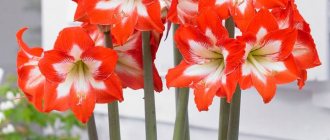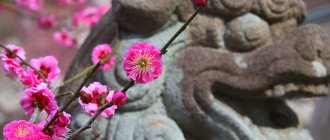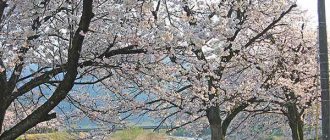Legend of the Flower of Death
Lycoris is the European name of an oriental plant, derived from the name of the beautiful Nereid (sea nymph). According to Asian legend, the flower was looked after by the spirits of the plant world Manzhu and Saga. The first was responsible for the flowers, the second for the leaves. One day they forgot about their assigned work for the sake of meeting each other. God chose a cruel punishment for the lovers: to seem to be close, but not to be able to see each other. During the flowering period of lycoris, the leaves dry out, and when they appear again, the flowers are no longer there.
In Japanese culture, special significance is given to the bright red variety of lycoris.
The Japanese usually plant this flower in the cemetery and use it in mourning ceremonies, because they believe that it grows at the edge of the underground roads of death. Other plant names:
- manjusaga (in honor of spirits in love);
- higanban (meaning: “autumn equinox flower”);
- heavenly flower;
- ghost flower;
- fox flower;
- demon lily;
- spider lily;
- flower of the dead;
- desert Flower;
- razor flower;
- hell flower;
- flower of death.
Video: lush lycoris bloom
Diseases and pests
The spider lily is resistant to disease, but improper care can lead to the death of the flower. The main problem is rotting of the bulb due to the accumulation of moisture in the soil . Regulating watering and timely replanting will help save the flower.
The main enemy of lycoris is the narcissus fly . It is impossible to save a plant after being infected by a parasite, so the bush is preventively sprayed with insecticides to prevent the appearance of the pest.
Features of growing ornamental crops
Licorice is a bulbous perennial up to 70 cm high. The leaves are long (up to 60 cm), but the width is maximum 20 mm. The plant is quite thermophilic and can only winter in the southern zones. So, it has taken root well in the Krasnodar region.
After the summer rest, when the leaves disappear, the bulbs throw out flower stalks in the last days of August or in the first days of September. They rapidly gain height: in 5 days, the arrows can grow up to half a meter. Fragrant bouquets on straight bare stems become a decoration of the garden. In one variety of fox flower the filamentous stamens are much longer than the petals, in another they are almost flush.
Due to the unusual stamens, the flowers resemble members of the spider family.
In nature, lycoris bloom anywhere
Lycoris color palette:
- white;
- yellow;
- golden;
- red;
- lilac;
- orange;
- pink.
The flowering period lasts about 15 days. After wilting, narrow arrow-shaped leaves are formed that survive until the end of spring, beginning of June.
After pollination, fruits appear: 3-channel capsules with small black seeds. However, lycoris is usually propagated vegetatively: by daughter bulbs. Many species do not form seeds, so in most cases it is impossible to grow this crop with their help. When propagated, the bulbs of the crop form dense fused rhizomes - this is good for strengthening the soil.
Examples of use in landscape design
Delicate shades look good against greenery
The Japanese garden is a wonderful place to grow lycoris
Red and white is one of the winning combinations
Licorice plants in the form of living borders do a good job of dividing the garden into zones
Lycoris will also take root well in pots.
You can plant solo by mixing several colors of spider lilies
Features and use of lycoris in decoration: photos and videos
Licorice is a perennial plant from the amaryllis family, all parts of which are poisonous. The length ranges from 30 to 70 cm. It is propagated by bulbs whose diameter is 5 cm. The tip of the shoot is decorated with an inflorescence of large buds. One bulb produces 5-7 flowers per season.
Licorice in Japan
On the site, lycoris is planted in the border, in the flowerbed. The plant feels best when planted in a group. Low-growing flowers are chosen as neighbors. Original gardeners for the group choose ferns, crocuses, hostas, and begonias.
A popular topic is the design of small ponds. Next to them are placed a boulder, lycoris and iris.
Popular varieties in the photo
Most often, this flower is found in gardens in the south of Russia, less often in central Russia. Flower growers prefer several varieties of ghostly flowers.
- Golden lycoris. It does not tolerate temperatures below –5°C. Often it is grown only at home. Its height is slightly more than half a meter. The diameter of the canary-colored tubular flowers is 10 cm. There are usually no more than 6 of them in an inflorescence. Blooms in May or early June.
The height of the golden flower is about 60 cm
- Lycoris is blood red . Short compared to other varieties: only 45 cm. Tiny leaves grow from April to June. In August, scarlet flowers bloom. The peduncle usually contains 5–6 buds with a diameter of 5 cm.
Lycoris sanguinea blooms at the very end of summer
- Lycoris radiata. A highly decorative perennial with long filamentous stamens and unusual petals. The lateral “antennae” are bent back, and the central petals resemble a wavy arc. Large flowers are pink, white, terracotta (the color of baked clay). The height of flower arrows reaches 30–70 cm.
Lycoris radiata blooms for more than a month
- Lycoris squamata, or scale-bearing plant. The most cool-loving species with inflorescences of 8–9 buds. The funnel-shaped flowers smell pleasant. The color of the slightly curved back petals is soft pink with a lilac tint, and the core is yellow. The height of the plant is 60–70 cm, it reproduces by daughter bulbs. Basal leaves appear at the end of the flowering period.
This variety can successfully survive the winter without shelter.
Video: Lycoris radiata in Japan
The most beautiful flowers in the world
Many gardeners give first place in terms of flower beauty to the chrysanthemum. No matter how surprising it may sound, the Japanese themselves are also very fond of this plant. At the same time, chrysanthemums are grown in Japan not only in late summer and autumn, but from the beginning of spring. This asteraceous plant is so diverse and beautiful that the beautiful roses familiar to many can only envy the coloring of chrysanthemums, the fullness of their buds and the number of varieties. The best poets of Japan very often praise the chrysanthemum in their poems. The Japanese not only admire these flowers, but also often add them as additives to a variety of dishes or drinks, such as teas.
The chrysanthemum in the land of the rising sun is not only praised, but exhibitions dedicated to it are also often organized, and incredible compositions are created from flowers that an ordinary person cannot even imagine.
The second most beautiful and majestic Japanese flower is, of course, sakura. It is with this that the Japanese most often associate the tradition of admiring hanami flowers, because shortly before the cherry blossoms begin, even on TV they make forecasts for the flowering of trees in a particular area, so that local residents and guests of the country can enjoy the beauty of the flowers, their grandeur and luxury. Almost everywhere you can find gardens and parks with sakura, which during flowering will make any area especially beautiful, peaceful and suitable for spending time.
Among the unusual but very important plants in Japan, we should note the mythical benibana, which on the mainland is often called the scarlet flower. The color of this flower is very unusual - orange with a mixture of crimson. Benibana blooms in the summer, when all the mountains are covered with scarlet carpets. The flower itself belongs to the chrysanthemum genus and is very similar to the domestic thistle.
Methods for planting lycoris
It is best to grow lycoris in the fall. Bulbs are planted on the site a month before frost, so that they have time to get used to the soil and sprout roots. Some people plant in the spring, but then there is a high probability that the capricious plants will get sick and will not bloom the next year.
Favorable conditions for growing lycoris:
- climate similar to natural habitat;
- a well-lit and heated place without stagnant water;
- protection from drafts and gusts of wind;
- protection from direct sunlight by partial shade of large deciduous crowns.
Spider lily grows well in the shade of trees
Landing rules:
- Choose a suitable area, preferably with sandy or slightly acidic loose soil.
- Clear it of weeds and dig it up.
- If necessary, add peat, humus, and coarse sand to the soil.
- Level the soil.
- Make the distance between the holes: 25–30 cm. Cover the bottom of each with a layer of sand.
- Plant large bulbs, slightly pressing them into the substrate, to a depth of at least 14 cm.
- Cover the bulbs with sand and the remaining empty space with leaf soil.
- Compact the soil in the hole and water it abundantly.
Camellia: a beautiful flower with healing properties
Camellia is a flower with soft red rounded petals. Camellia branches are strewn with lush green leaves, they are oval in shape and end in sharp protrusions. The camellia bush can reach from 2 to 20 meters in height.
The plant is used in perfumery; pain relievers, antiseptics, and oil are made from it. Camellia is also used to make solutions to combat harmful microorganisms. But the bush is known not only in production. He also found a place in legends and myths. History of the camellia and its role in mythology Camellia received its name from Carl Linnaeus. He named the bush after the Catholic scientist Joseph Cameli, who brought the plant to Europe. According to Japanese myths, a knight who touches a camellia suffers death by cutting off his head. They thought so because the flower does not fly away when it withers. He falls onto the grass whole, like a severed head.
Camellia has taken root not only in Japanese mythology: the ancient Greeks also composed a legend about it. This tale is as follows: “Cupid was loved by many earthly women. One day he got bored with them, and the young man went to look for a companion on other planets. For a long time he flew among the stars. Finally, Cupid landed on Saturn. In front of him lay an ice-bound lake, surrounded by tall ice blocks that glittered in different colors. Suddenly Cupid heard someone singing. He flew towards the sound and saw two girls of incredible beauty: their delicate skin was white, their eyes were blue, and their hair shone with silver. They sang: “Thank God for our icy bodies. Their cold drowns out attraction, suppresses feelings and prevents fire from flaring up.” The song stopped, and the beautiful creatures began to look at Cupid. The young man pulled out his bow and began to shoot his arrows at the girls, but no matter how hard he tried, they were cold to the impulse of his heart. The destroyed Cupid returned to Aphrodite, his mother. In tears, he told her what had happened. The goddess of beauty judged that these creatures were not worthy of being virgins. She turned them into flowers, which are now called camellias, and sent them to the human world.
How to plant camellia correctly
Camellia can only grow in a bright and warm place. In addition, you should not water it often. Before planting, you need to poke small holes in the seeds to give them the opportunity to sprout quickly. Afterwards they should be placed in a container with water. If the water temperature is high, the seeds should be removed after a few hours; if the water temperature is neutral, after two to three days. In the container where the camellia will grow, you need to place drainage in advance. Then the seeds must be placed in a substrate in which moss should be 70% and perlite 30%. Afterwards, the seeds should be placed 5 centimeters into the ground and either glass or transparent oilcloth should be placed on top. Next, the container with seedlings needs to be placed in a warm room. The substrate must be regularly saturated with moisture. When the length of the roots increases by 5 cm, the sprouts will need pinching. After this procedure, the seedlings need to be placed in pots 10 centimeters high.
Camellia care
Camellia is a sensitive plant. Do not plant it in a place that is too cold or hot. If the temperature drops below 10°C, the plant will die. In winter, the permissible temperature range is 7-13 ° C; at this time, camellia should be kept at home in a cool room. The plant does not tolerate sunlight. It is better to plant it in the shade. Also, camellia needs to be constantly sprayed. It needs regular watering throughout the year. The plant should be replanted every 3-5 years. From the beginning of summer to the end of September, camellia should grow outdoors.
Caring for a plant in the garden
Lush lycoris will become a real decoration of your garden
Caring for this garden crop consists of timely watering, loosening the soil around, pulling out weeds, feeding with nutrients and preparing for winter. From time to time, lycoris needs replanting.
During the active growth of peduncles and leaves, the plants are watered regularly so that only the top soil layer dries out. The lower layers of soil should always be slightly damp. During the winter dormancy period, watering is not required, during the summer dormancy it is reduced to a minimum.
Recent Entries
Lilac perennials that are beautiful, compact and do not crowd out other plants Why when buying seedlings you should not take the sellers’ word for it and how to determine the age of the plant using 3 signs Tomato seedlings have turned purple or whitish: why the color has changed and how to save the plants
Nutrients are added in the spring and at the beginning of flowering, as well as in cases when the flowers do not look too healthy. But you should not be zealous in this matter. Preference is given to mineral fertilizers for bulbous crops. Apply fertilizer at the root, having previously dissolved it in several liters of water. The main thing is to follow the instructions on the package. It is better not to add nitrogen, especially in the fall.
Features of care
The most important rule is that you can only work with the plant while wearing gloves. All parts of the flower are poisonous and can cause poisoning.
In spring and summer, lycoris needs to be watered. It especially needs watering during the formation of leaves and flower stalks. The soil must be constantly moistened (4-5 times a week), preventing the soil from drying out.
When lycoris goes dormant (after flowering and before the formation of leaves and buds), it is watered moderately once. In winter, after snow falls, the procedure is stopped.
The subcortex is carried out every 2 weeks during the growing season. From the beginning of leaf growth, they are fed with water-soluble nitrogen fertilizers. When buds appear, feed with a high potassium content is used.
Also, for abundant flowering, you can place a fluorescent lamp for 2-3 hours a day at the beginning of flowering.
The plant should be pruned only in the fall, after flowering. Dried leaves are cut off with sharp scissors. There is no need to remove anything else.
The plant does not require annual replanting, like many bulbous plants. It is enough every 5 years, after flowering, to dig up the bulb and separate the children from it using a sharp knife. The place where the bulb is broken is sprinkled with coal powder or ash.
Problems during cultivation
Prolonged exposure to sunlight may cause burns. This has a bad effect on the general condition of the flower. Damaged areas are cut off with scissors.
Licorice must be protected from constant winds and drafts.
Illiterate care not only increases the chance of disease, but also reduces the splendor of the inflorescence.
Transfer
There is no need for annual replanting; with frequent division, the flowers weaken. It is enough to do this once every 5 years, following simple rules:
- Prepare a new place for lycoris.
- Dig up the bulbs and carefully separate the babies.
- “Dust” the places where they were with wood ash.
- Plant in a prepared area.
- Do not water the soil during autumn replanting.
A year or two after transplantation, lycoris may not bloom.
Duality of the image
Despite all the fear with which the shark is perceived by the inhabitants of Japan, it is at the same time a sacred animal. If fishermen have to hunt a shark, it is preceded by special rituals, since the predator can simultaneously be a messenger of the deity. In this case, she will be called Same. Moreover, when treated with respect, the divine shark helps sailors: its power is enough to provide the ship with good weather and the crew with a rich catch. If you get a tattoo in the form of an inhabitant of the sea waters, then, according to popular belief, it will become a wonderful amulet and will protect you from a variety of troubles in life.
Preparing for winter
At the end of autumn, dried flowers and leaves of the plant are removed. Bulbs are not dug up for the winter. If they are deeply rooted, they are not afraid of frost, but only on condition that the distance from the bottom to the surface of the site is at least 30 cm. If weather forecasters promise a harsh winter without snow, the flower is covered with dry grass, leaves, spruce branches or agrospam before the arrival of spring.
The flower does not really like the cold, so shelter will not hurt
Choosing a site for planting and preparing the soil
In nature, the flower grows in semi-shaded places, next to trees. It does not tolerate the scorching rays of the sun or pitch shadow. It is also negatively affected by wind and constant drafts.
The best place is an area next to a fence, a building, or surrounded by other medium-sized shrubs and flowers.
At home, you should place the flower on the western or eastern side.
The soil for a flower is ideally sandy or slightly acidic with loose soil. The rich presence of humus guarantees a lush inflorescence. The flower prefers a light substrate, composed of humus, foliage and turf soil in equal proportions.
Before planting, the soil is cleared of grass, dug up, and leveled.
Landing dates
Planting must be done in mid-to-late October before frost sets in so that lycoris has time to take root.
You can plant it in the spring (mid-April), but with a high probability the plant will often get sick.
Problems with cultivation, pests
Licorice is resistant to diseases and all pests except daffodil flies. To prevent them from causing harm, during the period of active growth, the flowers are watered with a solution of an insecticidal preparation.
Lycoris is poisonous, especially its bulbs. In order to comply with safety precautions, flower growers work with it only in thick rubber gloves. It is grown in a place inaccessible to children and pets.
If you do not follow the watering regime, root rot may appear due to excessive soil moisture. With prolonged exposure to direct sunlight, the leaves receive burns: light, as if burnt out areas. This has a bad effect on both health and the appearance of the crop.
Higanbana - the flower of samurai honor and death in battle
Plant properties
Licorice is not used as a medicine. This plant is poisonous, so it is strictly prohibited to use it internally.
In Chinese folk medicine, the flower is used to stir up phlegm.
Licorice is an unusual flower that can decorate any garden when properly combined with other crops. Caring for it is simple, and it is not damaged by various diseases, so there will be no fuss with it. The main thing is to remember when working about precautions so as not to harm yourself.
Reviews about growing lycoris
Like all bulbous plants, Licorice squamosum is planted to a depth of 3 times the diameter of the bulb. Sunny or slightly shaded place, sandy or loamy soil, rich in humus. Does not form seeds, reproduces vegetatively.
Yuriks
https://frauflora.ru/viewtopic.php?t=3222
Lycoris can be not only white, yellow, red, it can be pink and blue i.e. blue or light blue.
Elfya
https://forum.bestflowers.ru/t/likoris.44097/
In our conditions, lycoris should be grown like nerines. Like many amaryllis, they do not like transplants, so they cannot be grown like gladioli. Moreover, you probably noticed that new leaves grow on them at the end of summer and autumn, and remain throughout the winter.
I grow Nerina Bowden in a 10 liter container; after flowering I don’t water it and put it in an unheated room at about +5 degrees. until spring. Then the leaves begin to grow and light, watering and fertilizing are needed. As soon as the weather permits, I take it out into the open air. And so it grows all season. At the end of July-August I stop watering and fertilizing and place it under a canopy, arranging a dry period. In autumn it blooms. Lycoris can be grown in the same way, but their leaves do not die off in winter, so they need to be kept cool with maximum light and slightly moistened. The most persistent one, Lycoris squamigera, overwinters in zone 5.
Alik
https://www.flowersweb.info/forum/forum7/topic112581/messages/
Licorice is a beautiful plant with a stunning legend. In Japan, in the language of flowers, it means “I look forward to meeting you again.” With proper care, it will please gardeners for many years.
Last news
Our address
p. Voskhod, st. Voentorgovskaya 4/16 Opening hours:
Every day from 11.00 to 19.00, seven days a week
Phones: +7 +7-913-712-3709
WhatsApp, Telegram, Viber (for messages)
Your contribution to the exhibition
Funeral Portal News
Souvenir shop
Honoring Dead Ancestors in Japan
The deceased become patrons of their family. They are given respect - for this purpose an altar is provided at each house. Ancestors are revered in different regions; this is one of the foundations of religion. After death, the soul of the deceased needs the support of loved ones - a memorial service is held.
THE DECEASED ARE CONSIDERED AS FAMILY MEMBERS UNTIL THE CHANGE OF 2 GENERATIONS OCCURS, THEN THEY ACQUIRE THE STATUS OF DIVINE.
Honoring the Dead
Sakura / Sakura
Sakura (Japanese - Sakura ) - Japanese cherry. Wild sakura grows in China, Korea and Japan, but in Japan new varieties have been bred for a long time (there are several hundred of them). The most popular type of sakura is Somei Yoshino . Its petals are pure white, only slightly pinkish at the base of the flower. Fuyuzakura - winter sakura begins to bloom in the fall, and sometimes also in winter. Yaezakura has large flowers with dark pink petals. Shidarezakura (weeping cherry) has long branches hanging down with a cascade of pink flowers. Small sakura fruits are not eaten. In cooking, salted or pickled flowers are used (to add flavor to dishes), as well as leaves in which sakura-mochi, sweet rice balls with sweet bean paste, are wrapped.
Camellia / Camellia / Tsubaki
Japanese name Tsubaki . Belongs to the tea family. In Japan (and beyond), the most famous is the Japanese Camellia (Camellia japonica) , which originates from Southwestern China. Wild camellia is an evergreen shrub 6-9 meters high with red flowers 5-8 cm in diameter, having five to six petals and dense stamens. Many hybrids of red, pink, cream and other colors have also been bred. Some of them are double, similar to roses or peonies. One of the names of camellia is “winter rose”. In areas with a mild climate, it can bloom in the middle of winter; the flowering period is 4-5 months. Camellia is widely used for landscaping parks, gardens and indoors.
Landscape planning for a summer cottage and Japanese flower garden
Before planting Japanese flowers, you should definitely draw up a design for the landscape of your summer cottage and a plan for the future flower garden.
So, if we take into account the beginning of the 90s, it can be noted that the builders and designers of that time faced many obstacles that they could not overcome due to the poor development of the architectural industry. Today, even the specific topography that the regions of our country have is not an obstacle to the construction of beautiful summer cottages. As you know, many regions of Russia cannot boast of a uniform relief, since in some places the height difference is several meters
Such a landscape is a significant obstacle to further design of flower beds and country gardens. The Japanese flower garden is no exception, for decoration of which it is advisable to choose a flat and horizontal area. The primary task in such a situation is to strengthen the crumbling soil. To strengthen the slope, it is possible to use special mesh structures - gabions. They do not require a special foundation or cladding, so they are very convenient for landscaping
As you know, many regions of Russia cannot boast of a uniform relief, since in some places the height difference is several meters. Such a landscape is a significant obstacle to further design of flower beds and country gardens. The Japanese flower garden is no exception, for decoration of which it is advisable to choose a flat and horizontal area. The primary task in such a situation is to strengthen the crumbling soil. To strengthen the slope, it is possible to use special mesh structures - gabions. They do not require a special foundation or cladding, so they are very convenient for landscaping.
The uneven terrain, in addition to steep slopes, poses other obstacles to the arrangement of Japanese gardens - these are obstacles in the form of decay between two hills. Sometimes builders solve this problem by building a special “dam” that fits perfectly into the landscape. The resulting “dam” can be decorated with the construction of alpine slides, waterfalls, miniature ponds, etc.
When arranging the landscape of a summer cottage in the Japanese style, a huge role is given to design work, since during its implementation it is possible to carry out an ideal analysis of the existing territory, taking into account all the features. Then, based on analytical data and measurements, it is possible to draw up a successful project for the future site, and thereby find a rational solution that, after a certain time, can make your dream come true.
Decorating a garden plot in Japanese style will provide you with a large area for creativity. The garden can be decorated with different characters in the form of stone sculptures. Recently, various characters and animals have become popular. For example, these could be unusually shaped flower pots. In general, any object that can be skillfully combined with plants will become a bright decorative detail that gives your garden individuality.
Hydrangea / Hydrangea / Ajisai
Japanese name Ajisai. Most types of hydrangea are shrubs 1-3 m high. The flowers are collected at the end of the stem in spherical inflorescences. The most popular large-leaf hydrangea (more than 600 varieties) has flowers that can be white, blue, lilac, pink, red (depending on the acidity of the soil). In Japan, the peak flowering time for hydrangeas is the rainy season (mid-June). Around many temples and shrines there are many hydrangea bushes (sometimes up to 150 thousand): Meigetsu-in in Kamakura, Fujimori Jinja, Tofukuji in Kyoto. During the flowering season, Hydrangea Festivals (Ajisai Matsuri) are held in shrines and parks in Japan.
Japanese love for flowers
Having visited Japan, it is quite difficult not to notice the Japanese people’s love for flowers, because they are everywhere in this country, while the locals enjoy floriculture and grow amazing specimens that simply do not grow in other countries. In Japan, there is even such a thing as “flora art,” which is associated with the mystical beliefs of local residents and refers to a cult. The Japanese especially value flowers, snow and the moon as cults.
The Japanese love for flowers is also reinforced by the mild local climate, because a sufficient amount of moisture, warmth and plenty of sun contribute to the growth of incredibly beautiful and rare plants. The Japanese not only grow flowers, but also try to give them a special and unique appearance, for example, change the natural shade of the flower itself or make the flowering more lush and voluminous. By the way, the well-known art of ikebana also came to us from Japan and is arranging flowers .
General description of the flower
Homeland of the plant
She was immortalized on the French national coat of arms.
After several centuries, breeders managed to develop many varieties of the above-mentioned plant, which are grown not only in gardens, but also in city apartments.
Bulbs
Lily bulbs consist of many closely adjacent scales. The average size of the bulb is 7 centimeters, but can vary from 2 to 20 centimeters.
Leaves
The leaves of these bulbous plants can have a wide variety of shapes. The leaf can be either oval or lanceolate, or linear.
Petals
The petal can have a completely unusual color, ranging from white to various shades of pink, purple, lilac, red, yellow and golden orange. The edges of the petals can be straight or scalloped. Each flower consists of six petals.
Stem
The stem is usually fleshy. The leaves on them can be located either at the base of the bulb or evenly envelop the entire stem. There are usually 4 to 5 flowers on one stem.
Size
The height of the stems of these indoor plants can reach one meter, and the length of their petals can vary from 5 to 16 centimeters and depends on the variety.
Root
The root is located at the bottom of the bulb, but some varieties are characterized by the existence of additional roots that are located above the bulb.
Seeds
Around October-November, these representatives of the plant world ripen fruits, which are elongated boxes. Inside they are brown flat seeds.
See below photo:
In nature, there are about 300 species of Lilies, which can be divided into three main groups depending on the shape of the flower:
- Funnel-shaped, the petals of which are tightly collected into a kind of tube. This group includes the long-flowered lily Longiflorum, Regal, hybrid M >
IMPORTANT! The following types of this plant are most often used for growing at home:
Lilies do not require any special care at home. It is recommended to buy bulbs for planting the described plants in the autumn.
Before planting, be sure to keep the bulb in a 1% solution of potassium permanganate for half an hour.
The diameter of the pot for planting this plant should be from 15 to 20 centimeters, and it is necessary to lay drainage at its bottom, which will protect the plant from excessive moisture. On top of the drainage you need to pour a layer of soil 5 centimeters thick.
You need to place the onion in the center of the pot, carefully level its rhizome and sprinkle it halfway with soil. After this, the container with the Lily must be placed in a cool, dark place until green sprouts appear. The soil needs to be moderately moistened
When the sprouts appear, the pot should be moved to an evenly lit windowsill, and with the arrival of summer - to the balcony
The soil needs to be moderately moistened. When the sprouts appear, the pot should be moved to an evenly lit windowsill, and with the arrival of summer - to the balcony.
Basic rules for caring for indoors
- From the day the shoots sprout until the leaves dry out in the autumn, the lily must be watered regularly, avoiding drying out and excessive moisture of the soil.
- The leaves of the plant must be periodically sprayed with water.
- The soil needs to be loosened by adding humus, leaf soil or peat.
- Weeds need to be removed regularly.
- Before flowering and during its period, the lily must be fed with liquid fertilizer.
- After the flowers bloom, the stems should be tied to sticks.
The Lily plant does not require any special care, but it does not tolerate excess moisture. The Lily flower is a plant that prefers good lighting, cool air and space. And if you add regular fertilization to all these conditions, the bulbous beauty will delight you with its regular flowering for several years.
If you find an error, please select a piece of text and press Ctrl+Enter.
Meaning of lily tattoos
Dracaena palm tree: cultivation and care at home, types with photos and descriptions
The meaning of this exotic flower has much in common with the symbolism of the lotus. For girls, it is the personification of nobility, spiritual harmony, tranquility, hope, innocence and greatness, glory. The Royal Lily is a symbol of endless love, devotion and fidelity to one’s chosen one. Female representatives often prefer the royal or fleur-de-lis. Previously, such a plant adorned the coats of arms of French monarchs. The heraldic lily is one of the varieties of this popular ornament. It doesn't look like a real flower at all. Typically, this design is chosen by women who want to emphasize their noble origin and high financial status.
A stem with several flowers is a symbol of immortality, and such a tattoo will bring wealth, health, and success to its owner.
The lily did not always have a positive meaning. Previously, such a flower was a mark of women of easy virtue. And in places of detention, such an ornament was made by gay women.
What does tiger lily mean? This is a symbol of originality and independence; this type of ornament is chosen by creative individuals.
The water lily is a water lily, since ancient times it has been considered a symbol of purity, innocence, purity and beauty. Many people believe that such a tattoo makes their cherished desires come true, because a water lily appears from a star that fell from the sky.
There is another type of tattoo - the spider lily, “cutting demons.” According to ancient legends, it protected its owner from evil forces.
When applying a design to a body, its color matters. The white lily, just like the rose, is considered the queen of flowers. A delicate pink bud emphasizes the romantic nature of its owner.
Experts in the world of tattoos recommend that passionate women with a strong character give preference to open buds in dark colors. A black lily will indicate the girl’s temperament and passion.










